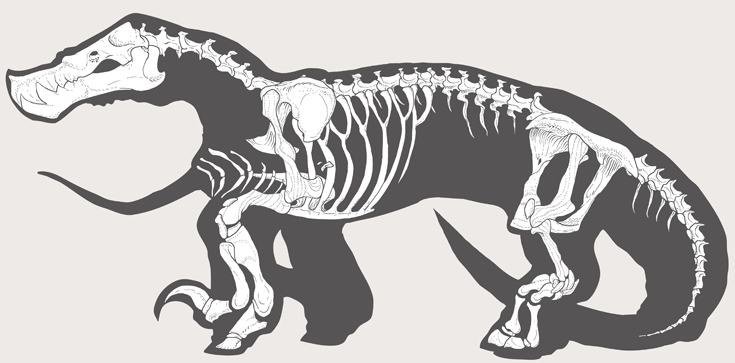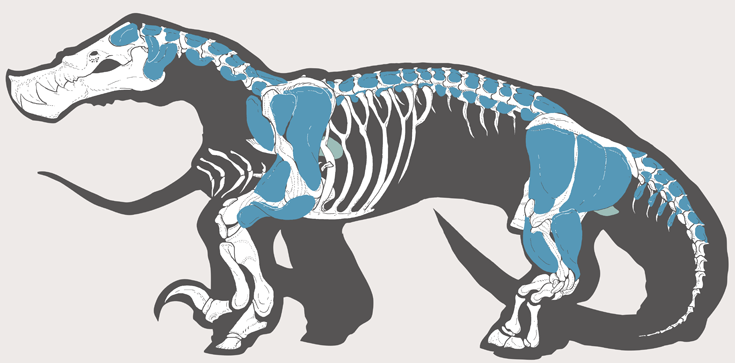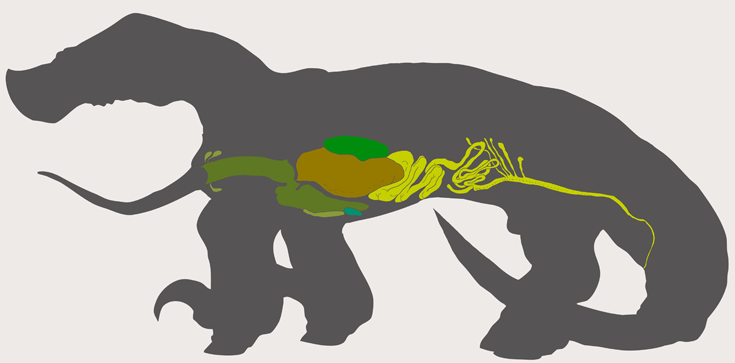Basic Anatomy
of Snaiadi "Vertebrates"
At first sight, the anatomy of Snaiadi “vertebrates” might confuse the common observer. Most of them use genitals, which look like mouths, to catch their prey. They then use their second heads, which look crudely like mammalian genitals, to consume them. To reduce this confusion and shed more light on the lives of these organisms, a very simplified guide to Snaiadi “vertebrate” anatomy is presented here. The sample animal is the Lebanese Kahydron, Kahydron libanesiensis.
Please remember that features listed here vary considerably among different groups of “vertebrate” animals. Furthermore, several details are omitted in these diagrams.

Details of the skeletal system:
The Snaiadi skeleton resembles that of an Earthly vertebrate’s for only a very brief time. To begin with, the chief material in Snaiadi bones is not calcium, but a modified hydrocarbon composite that resembles very hard wood. Bones of Snaiadi animals are usually brown, green or black in color, and readily burn when heated. Because of this, fossils of Snaiadi “vertebrates” are comparatively rarer.
The first-head skull of most “vertebrates” is composed of two shell-like components. In some of the primitive herbivores, these skull bones do not even ossify. In predators like this Kahydron, they are massive and durable.
One of the most noticeable aspects of the “spinal column” is the serial presence of hollow spaces for hydraulic muscles to fit in. Whereas Earthly animals have flanges for pull-muscles to attach to, Snaiadi bones have a lot of such hollows and scoopings for the piston-like hydraulic push-muscles to fit in. This is especially noticeable in the upper leg and arm bones, which are twisted into disturbing shapes to better gain the leverage of the hydraulic muscles.
The front and back limbs attach to the spine via looking hip and pectoral girdles. The front girdle is termed the pectoral armature, while the rear one is called the skid. While seemingly solid, these structures evolved as the four separate leg-girdles of the early, eight-legged “vertebrate” ancestors merged into each other. The pectoral armature also sports a cerebral keel, which the brain and the worm basket organ attach themselves to.
Besides these organs there is a second, sternal keel that supports the second head. In the case of this Kahydron, the sternal keel is enlarged for the attachment of the long, fibrous muscles of the second-head tongue. In front of the sternal keel lies a series of mouth-struts that enable the second-head mouth to open and close. In the large, advanced herbivores, these struts have vastly increased in number and size. These animals can almost be said to have a second skull, complete with specialized rasping and grinding plates derived from hypertrophied mouth-struts.
It is interesting to notice that while a working jaw mechanism could conceivably have been derived from these organs, no group of “vertebrates” except the advanced herbivores and (to an extent,) the Jetocetes and the Cardiocetes, use them for this purpose. (The “true jawed” Tromobrachids go around this rule by turning their front limbs into fake “jaws.”) It is thought that a developmental quirk in “vertebrate” ontogeny, perhaps related with the placement of the lungs and the digestive system, might hinder the development of true second-head jaws in Snaiadi “vertebrates.”

Details of the hydraulic muscles:
These organs are a novel Snaiadi invention with no analogues anywhere else in known space. Derived directly from the water-vascular system of the sea cucumber-like “vertebrate” ancestors, these organs give their owners tremendous strength relative to their size.
Hydraulic muscles move by pushing instead of pulling. As they expand, they push one bone against another, moving them. As mentioned before, the limb and vertebral bones of the Snaiadi “vertebrates” have unusual forms to accommodate this difference.
Hydraulic muscles come in differently sized lobes with honeycomb-like partitioning inside. These self-sealing segments make the muscle lobes resistant to puncture, and prevent the whole system from failing if a single lobe is disabled. All hydraulic lobes are connected together with an elaborate system of hydraulic trachea, which is omitted in this illustration for clarity.
Besides the muscles, all Snaiadi “vertebrates” have two pairs of reservoirs between their pectoral armatures and skids. These organs help clean and replenish the hydraulic lymph supply, and also helps accommodate volume change in the entire system. When Snaiadi “vertebrates” sleep, most of the hydraulic fluid gathers in these reservoirs for daily cleansing. Newly-awakened “vertebrates” seem to have thinner limbs and fatter bodies, as it takes a while for the fluid to fill up the limbs and the spine.
The hydraulic network also doubles as the “vertebrate” lymphatic system, releasing chemicals and specialized fiber-cells to combat pathogens in the body. The exact workings of this system are not clearly understood.
The Kahydron in this illustration is noteworthy for having modified a part of its first-head neck lobes into a tremendous jaw-closing muscle. This structure gives this lineage their enormously strong biting power.

Details of the fibrous muscles:
While the hydraulic system is the chief agent of locomotion, Snaiadi “vertebrates” also have a comprehensive set of “regular,” fiber-based muscles.
These “conventional” muscles are based on protein-like structures analogous to actin and myosin in Terrestrial organisms. They cover the entire body and help locomotion by squeezing individual hydraulic lobes, pumping the fluid from one part of the system to another. Certain parts of the limbs below the knees and elbows are motivated solely by fibrous muscles. The first-head jaws, (this Kahydron forms an exception,) the second-head mouth, the tongue and the tail are also all motivated by fibrous muscles. There are different types and sub-types of fibrous muscles in different organs. For example, the muscles that make up the second-head tongue are extremely elastic in most species, able to stretch up to eight times their length.

Details of the digestive system:
The Snaiadi “vertebrate” digestive system is roughly similar to those of Earthly organisms. The second head opens into an atrium, where the long tongues of many lineages are stored when not in use. Following the atrium is a true stomach separated by a sphincter, where food is degraded and broken down. A large, liver-like organ contributes enzymes that help this process. This mysterious “liver” also seems to regulate the contents of “vertebrate” blood in a series of little-understood biochemical processes.
After the stomach, food gets passed into two knots of thick and thin intestine, where further breakdown of nutrients takes place. In advanced herbivores, these organs have swollen up into huge, churning sacs that take up a lot of space. Finally, in a final section called the “thin” intestine, nutrients are exchanged with the waste products in the bloodstream via thin, branching structures. Most Snaiadi animals pass off refuse as lightweight, dry excrement.

Details of the respiro/circulatory system:
All Snaiadi animals respire oxygen and give off carbon dioxide. The cellular, metabolic and molecular mechanisms of Snaiadi respiration, while performing roughly the same function as those in Earthly organisms, are based on completely different, alien arrangements.
Air enters the bodies of most “vertebrates” from nostrils located under the armpits. In some lineages, these openings have migrated to the sides, or even the top parts of the body. A tough spigot of cartilage and bone surrounds the nostril, ensuring that airflow is maintained even when the legs are pressed against the sides. The nostril also houses the vocal cords in most “vertebrate” species. Those Snaiadi animals that vocalize always do so in stereo, from two separate sets of vocal cords on either side of the body. Some of the more elaborate songs performed in this manner have an enchanting, otherworldy effect on human listeners.
Following the vocal cords and the short breathing tube, the respiratory tract divides off into two halves. These two halves work in a complimentary two-stroke cycle and drive forth respiration in the animal. Thanks to this adaptation, Snaiadi “vertebrates” never need diaphragms. In this Kahydron, the first half of the lungs extends into the forelimb. As the animal runs, the moving front limbs help pump more oxygen into the body in a positive-feedback cycle. This system is even more developed in certain other “vertebrates” such as the pneumagazelles. Other animals, on the other hand, may or may not have such an arrangement. This double-split arrangement is repeated in both sides of the body. Each lung-bellows pair operates independently from one another. In certain lineages, especially the myriad snake-like forms, the lung system on one side has atrophied to save space.
The circulatory system of Snaiadi “vertebrates” is unique in having a special oxygenator organ that diffuses oxygen directly into the heart. In advanced “vertebrates”, this system has evolved into its most efficient state. Less derived lineages such as the polydactyls, turtiformes, muppajos and archaeognaths also have oxygenator organs, but they do not work as efficiently.
The oxygenator organ makes it possible to transfer energy rich blood directly to the power hungry fiber-hydraulic muscle complex. The main heart is a powerful, two-chambered engine that only pumps oxygenated blood. A separate collector heart, also two chambered, draws deoxygenated blood away from the rest of the body and shoots it back into the main heart. Notice that this system is mirrored on both sides of the Snaiadi “vertebrate” body, most animals have two sets of oxygenator organs, two pumper hearts and two collector hearts. Once again, there are secondary exceptions to this rule.
Besides the hearts, veins and arteries of most Snaiadi “vertebrates” also pump blood on their own with a collective “earthworming” constriction cycle. Some smaller “vertebrates” such as the picozoans have lost their hearts and circulate their blood exclusively through this mechanism.

Details of the nervous system:
While most organs systems of Snaiadi “vertebrates” are convergently similar to those of Earthly vertebrates, the nervous system of these organisms stands out as a truly alien structure.
Nervous systems in Snaiadi “vertebrates” seem to be a strange fusion of stringy, impulse-transmitting like “nerve” fibers and a network of nodes and vessels containing a salty, slightly acidic fluid. Electrical nerve impulses are generated and received with the finely branching nerve fibers, but they are transmitted from one end of the body to the other along the conductive fluid-filled vessels. A bundled pipeline of such vessels makes up the nervous pathways in the spinal and appendicular regions of most “vertebrate” animals.
This unusual combination of fiber nerves and fluid-filled vessels is also visible in the “vertebrate” brain. Anchored to the cerebral keel in the pectoral armature, the “vertebrate” brain is actually made up of two separate organs that work in tandem. One of these is a more-or-less “ordinary” brain, made up of a dense knot of fibrous nerves. The other is a maddening structure known as the worm basket; a sac filled with an extremely convoluted bundle of microscopic tubules. Within these tubes lies a series of millions of glands and vesicles that seem to communicate with each other with a cryptic alphabet of chemicals and protein equivalents. Scans have revealed that the tubes in the worm basket squirm, twist, corkscrew and coil against themselves when Snaiadi “vertebrates” are dreaming, or engaging in intellectually demanding tasks. It is highly possible that the Snaiadi worm basket is an “endocrine brain;” a chemical, as opposed to nerve-impulse-based seat of consciousness. The world-view offered by such a brain must surely be an unconventional one.
This mystifying organ mainly seems to play a role in recording memories. Furthermore, it has another function in “tainting” the vessel nerves across the animal’s body with a variety of chemical agents. These chemical flavors seem to modulate the behavior of certain nerves, making them fire faster, slower, or not at all. In certain cases, mostly associated with mating, some impulses are triggered only with a chemical signal and not an electrical one. Furthermore, such chemical signals apparently play vital roles in the animals’ growth and metabolism. The exact workings of these complex systems will doubtlessly take years of research to unravel.
Several sense organs help Snaiadi “vertebrates” perceive the world. The first head usually bears tiny, but efficient solid-state eyes with silicate lenses and no liquid inside. These lenses are shed annually to clean up the line of sight. Surrounding the eyes is an array of heat receptors that augment the animals’ sight with heat perception. The second head houses a variety of scent receptors that vary among different lineages. Different smelling organs also exist inside first heads, especially in males. Hearing is accomplished by sensing vibrations in a compact bone-in-bone structure that lies inside the tracheal spigot under the armpits. Finally, a second set of hearing organs exist under the front footpads of some “vertebrate” groups.

Details of the reproductive system:
All Snaiadi “vertebrates” reproduce through their first heads. The first-head jaws, which have become fearsome hunting instruments in this Kahydron, are actually derived from genital sheaths that used to protect the reproductive organs of the ancestral “vertebrates.”
This unconventional arrangement is a holdover from the distant ancestry of Snaiadi “vertebrates.” The earliest such forms were deep-sea burrowers that filtered seawater for nutrients. In order to avoid predators, they mated by extending long genital stalks out of their burrows. In time, these stalks acquired primitive sensual organs to better find their mates. Once the “vertebrate” ancestors started crawling out of their burrows, the sense organs were retained and the first head developed around the genitals.
This juxtaposed illustration shows both male and female genitals. In advanced vertebrates such as Kahydrons, the youth develop in a long, deep uterus that extends well into the animal’s chest. Near its birth, the embryo is forwarded into the gular sac. Birth occurs when the offspring are “vomited” out. In some species with small or very specialized first-head jaws; the youngsters slash their way out of the gular sac directly, using specially developed womb-beaks. The injuries that occur during this process heal quite rapidy, without permanent injury to the mother.
Live-bearing animals such as Kahydrons cannot carry many offspring. In return, however, they are able to better take care of those that are born. Other, less derived “vertebrate” lineages reproduce by carrying eggs in their gular sacs, laying and abandoning their eggs, or as in the case of Picozoans, regurgitating underdeveloped “worms” that later metamorphose into adults.
In male “vertebrates,” the space taken up by the gular-thoracic womb and ovaries is occupied with a wide variety of spectacular penises, and/or display organs.
Copyright laws protect all intellectual property associated with Snaiad.
All artwork, concepts and names associated with this project belong to C. M. Kosemen, unless otherwise stated.
